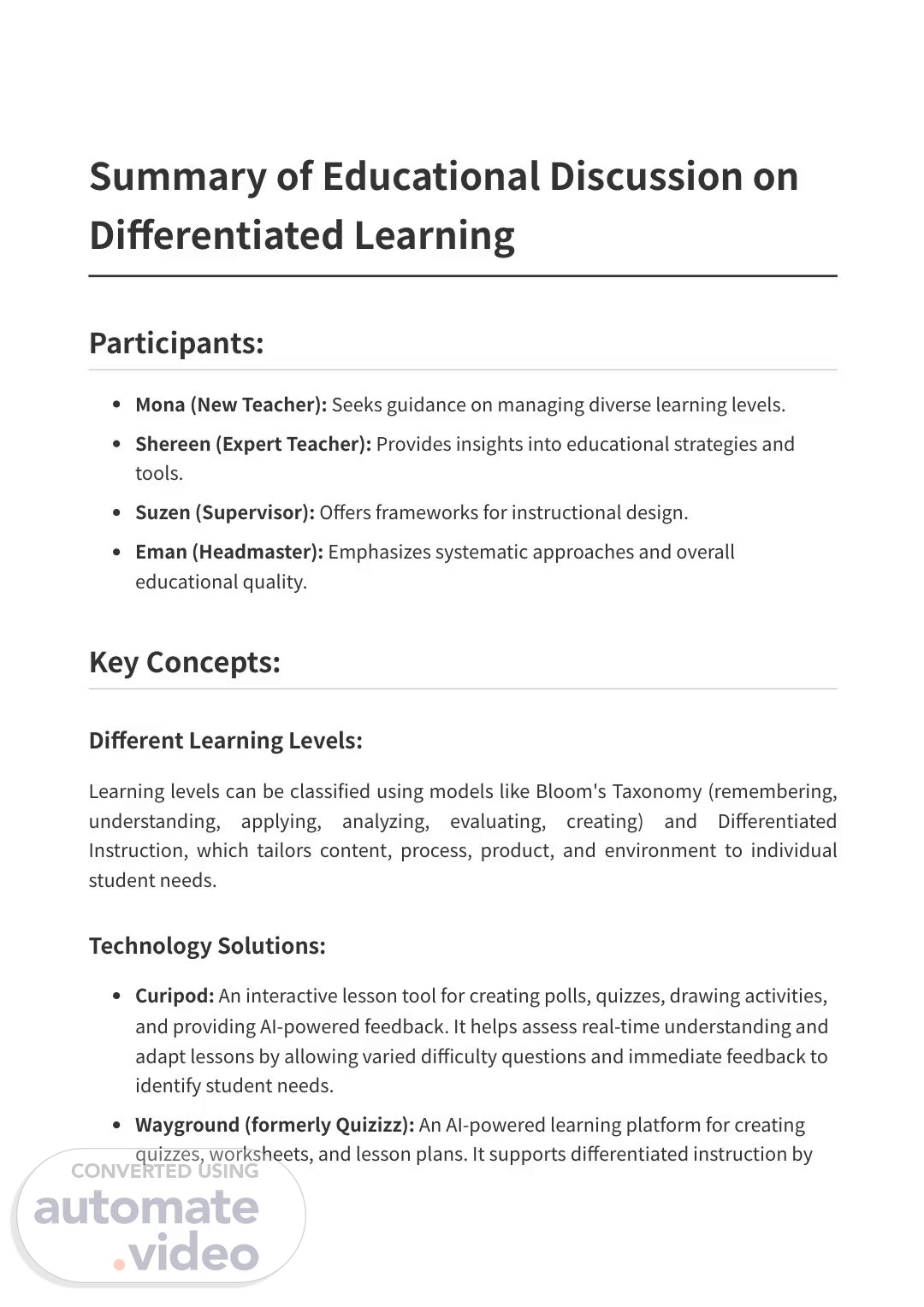Scene 1 (0s)
Summary of Educational Discussion on Differentiated Learning Participants: Mona (New Teacher): Seeks guidance on managing diverse learning levels. Shereen (Expert Teacher): Provides insights into educational strategies and tools. Suzen (Supervisor): Offers frameworks for instructional design. Eman (Headmaster): Emphasizes systematic approaches and overall educational quality. Key Concepts: Different Learning Levels: Learning levels can be classified using models like Bloom's Taxonomy (remembering, understanding, applying, analyzing, evaluating, creating) and Differentiated Instruction, which tailors content, process, product, and environment to individual student needs. Technology Solutions: Curipod: An interactive lesson tool for creating polls, quizzes, drawing activities, and providing AI-powered feedback. It helps assess real-time understanding and adapt lessons by allowing varied difficulty questions and immediate feedback to identify student needs. Wayground (formerly Quizizz): An AI-powered learning platform for creating quizzes, worksheets, and lesson plans. It supports differentiated instruction by.
Scene 2 (41s)
enabling varied difficulty levels in quizzes and assigning individual tasks, with detailed performance reports. Action Plan for Implementation: �. Familiarize with Tools: Explore Curipod and Wayground through tutorials and simple lesson creation. �. Identify Student Needs: Assess current student levels using diagnostic tests or observations. �. Design Differentiated Activities: Start with one activity or lesson incorporating varied learning levels. �. Implement and Observe: Apply the activity in class, noting successes and areas for improvement. �. Evaluate and Adjust: Use tool reports to assess effectiveness and refine future plans. �. Gradual Expansion: Integrate tools into more lessons as comfort grows. The ADDIE Model for Differentiated Learning: ADDIE is a systematic instructional design framework: �. Analysis: Identify learner profiles (struggling, on-level, advanced) and needs, including ability gaps and learning styles. �. Design: Plan tiered learning objectives (basic, proficient, advanced) and instructional strategies (content, process, product differentiation). �. Development: Create materials like scaffolded worksheets, collaborative tasks, and enrichment activities. �. Implementation: Facilitate learning through flexible grouping and choice boards. �. Evaluation: Measure effectiveness through formative assessments, data analysis, and student feedback to refine instruction..
Scene 3 (1m 37s)
Differentiated Learning for Mixed-Ability High School Classrooms: This approach combines Differentiated Instruction (DI), which adjusts content, process, product, and environment to diverse learners, with Universal Design for Learning (UDL), ensuring accessibility through multiple means of representation, engagement, and expression. Implementation Steps: �. Learner Analysis: Assess prior knowledge, learning styles, and readiness (e.g., pre-tests). �. Define Learning Objectives: Set tiered objectives (basic, proficient, advanced). �. Instructional Strategies: Differentiate content (varied materials), process (flexible grouping, scaffolding), and product (choice in demonstration). �. Learning Activities: Use tiered assignments, learning stations, learning menus, and collaborative group work. �. Assessment & Feedback: Employ formative assessments, differentiated assessments, and timely, growth-oriented feedback. Conclusion: Integrating technological tools like Curipod and Wayground with structured instructional design frameworks such as ADDIE and Differentiated Instruction provides a comprehensive approach to meet diverse student needs and enhance engagement in mixed-ability classrooms. Visual aids can further enhance the presentation of these concepts..
